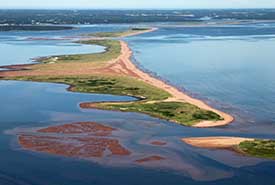Cascumpec Sandhills and Conway Sandhills

The Cascumpec Sandhills (Photo by Mike Dembeck)
The Cascumpec Sandhills and Conway Sandhills are two islands that are part of an interconnected series of sand dunes and wetlands on the north shore of Prince Edward Island. This 50-kilometre-long chain of dunes — stretching from Malpeque Bay to Jacques Cartier Provincial Park — is a high conservation priority for the Nature Conservancy of Canada (NCC). NCC has been acquiring and conserving lands in the Sandhills area since 2011, both through land purchase and land donations. Since that time, 202 hectares (500 acres) have been protected.
Described as PEI’s last true wilderness, the Sandhills are one of the least disturbed and most ecologically significant coastal dune complexes in eastern Canada. Unpopulated, and difficult to access, the area provides vital habitat for rare plants and many species of shorebirds. Located in an internationally recognized Important Bird Area, the Sandhills provide critical nesting habitat for endangered piping plover. Other notable shorebird species in the area include yellowleg, semipalmated plover, semipalmated sandpiper, sanderling, ruddy turnstone, red knot and black-bellied plover.
The Sandhills are covered and stabilized by American beach-grass, with patches of northern bayberry. Their salt marshes are dominated by saltwater cordgrass and saltmeadow cordgrass. Adjacent shallow water contains sea wrack. Gulf of St. Lawrence pinweed is a species of special concern and occurs on the Sandhills.
Cultural history
The Mi’kmaq of Prince Edward Island have a deep connection to Hog Island (the island furthest south in the chain) and the Conway and Casumpec Sandhills. They are home to an ancient and continuing Mi’kmaq land use tradition, important Mi’kmaq cultural and archaeological sites, as well as rare geological formations. Our conservation work on the Sandhills has been supported by funding from the Government of Canada’s Natural Areas Conservation Program and Ecogift Program. The American Friends of Canadian Nature (previously American Friends of Nature Conservancy of Canada) and many private donors also contributed generously.




